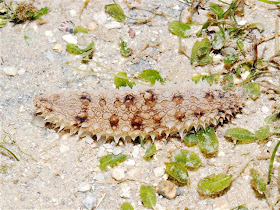It's our last predawn trip to Cyrene Reef this year and we were once again blown away by the diversity of marine organisms on this shore despite regular visits by the team for various purposes.
Today, most of us actually stayed put in one area for 1-2 hours (as you can see in this photo haha)! Simply because the shore is so rich that if you squat down and scrutinise every single corner of the seagrass and algae, something may just appear within your search vision. These camouflaged or tiny critters are usually overlooked if you explore the shore by just walking pass.
Of course, one must be rather blind if he or she misses the huge Knobbly sea stars (Protoreaster nodosus) along the way as there are so many of them on Cyrene Reef!
The juvenile versions of the Knobblies are ever so cute and adorable! Their presence suggests that the population on Cyrene is still regenerating.
We relocated this same Pentaceraster sea star (Pentaceraster mammilatus) found earlier this month.
It's my first time seeing this orange Pentaceraster individual which has been spotted here before. It has a pretty red spot in the middle. Unfortunately, this fellow has lost one arm and is slowly regenerating it back.
Today's been a wonderful day because my wishlists for the trip (or also known as prayer requests) has been answered. It was lovely to spot this juvenile Cake sea star (Anthenea aspera), a sea star that is not commonly found in the south.
There were many Synaptic sea cucumbers among the seaweed and seagrasses in black, brown or white. This one is a little more interesting... with yellow bands!
Marcus found a first sighting for the shore, the Polka-dotted sea cucumber (Holothuria ocellata).
That's not all, Marcus later also showed me his find of this weird sea cucumber. It looks like a Red sea cucumber (Actinopyga sp.).
Also red but not a sea cucumber, Chay Hoon spotted this tiny Little Ruby flatworm (Phrikoceros baibaiye) among the ascidians. Is this flatworm feeding on them?
Like yesterday, some parts of the shore are dotted with these Starry flatworms (Pseudobiceros stellae). Looks like they are in season!
The Swimming anemones (Boloceroides mcmurrichi) never fail to amaze me. I am still wondering if all the different forms, patterns and coloration of different individuals belong to the same species?
This peek-a-boo crab is one type that we have recently took notice on Cyrene. It hides inside a hole and carries the rock along as the ultimate camouflage. Looks like this fellow is really the king of crab camouflage as compared to the Velcro crab counterpart.
There were quite a number of moon snails in the dark and I saw an uncommon Zebra moon snail (Natica areolata). It has a pretty shell with white and orange bands. This snail is a great burrower and moments after I took some photos, it has disappeared into the sand.
This conch snail was found by one of us but I am not too sure of its identity.
Now over to the final segments.... slugs galore! Surprisingly, there were lots of these Emerald Stiliger slugs (Stiliger smaragdinus) found today. Pei Yan found one at Lazarus yesterday.
I wonder how I ever can spot tiny slugs like Chay Hoon... Proudly showing her my find of the 5mm slug, she says that this is a type of Gymnodoris nudibranch (Gymnodoris sp.). Never seen this before!
Geraldine and Rene were looking at a Cerberilla nudibranch (Cerberilla sp.) and when I came over to ask them whether is this the one they spotted, it turned out to be a second slug of the same kind which they missed.
This is the second nudibranch of the same kind found in the same tide pool. This slug has a broad, soft body with many long finger-like extensions (also known as cerata) arranged in rows. They are quite tiny though!
I spotted three of these Blue dragon nudibranchs (Pteraeolidia ianthina) together. Two of them refuse to let go of each other!
Are they mating?! Hahaha... Probably so!
A new sighting for me on this trip will be the Philinopsis sp. slug.
They are also known as tailed slugs. It has a
long, cylindrical body with a pair of 'wings' (called parapodia) which
fold over the centre of the body as well as a pair of 'tails, one longer
than the other.
Chay Hoon was just commenting before the start of the trip about this huge Forskal's sidegill slug (Pleurobranchus forskalii) and I managed to find it! It looks a lot more orangey than the maroon ones we see in the past. They used to be in season on Cyrene but are now not commonly sighted.
A special slug find would be this Melibe nudibranch (Melibe viridis)! I managed to find it towards the end of the trip. This was another critter on my wish list for today... thank God for showing me!
The cutest part about this slug is that it has an expandable hood which it uses to trap small prey! Looks like the perfect vacuum cleaner for the shore haha. :)
That's about all for this year's team trip for Cyrene. If I am not back here for Teamseagrass monitoring later this year, I will only get to revisit this splendid and stunning shore in 2013. Meanwhile, may the shore stay pristine as it is!
























No comments:
Post a Comment